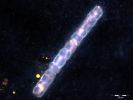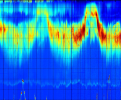
Aquatic Food Webs
Functional biodiversity enables aquatic communities to remain stable despite stressors such as temperature rise, increasing stratification or eutrophication. The Working Group on Aquatic Food Webs investigates functional biodiversity with regard to the biotic and abiotic factors that regulate the principal acquisition mode for energy including phototrophy, mixotrophy, and heterotrophy including herbivory, carnivory, and detritivory (in the following trophic functional groups: TFGs) in different compartments of aquatic food webs, as well as their supply with nutrients (namely nitrogen).
This is done by the analysis of nitrogen stable isotopes in amino acids. For the first time, this analysis allows TFGs and their inorganic nitrogen sources to be determined together from the same field sample, so that both can be directly related to the environmental conditions on site. This enabled us to show for the first time that entire food webs were functionally adapted to cope with stratification and blooms of unpalatable, N2-fixing cyanobacteria by switching their principal feeding mode from herbivory to carnivory in parallel to the aging of the blooms (Loick-Wilde et al. 2019). This is an important result because blooms of unpalatable cyanobacteria are expected to globally expand due to a changing climate. The transferability of the underlying environmental regulations for changes in TFGs to more dynamic ecosystems such as estuaries and river plumes is the subject of our current research and future projects.
A second focus of our group is the development and implementation of new interdisciplinary analytical approaches (see IOW partners) using GC-C-IRMS and GC-MS technologies to develop a mechanistic understanding of how amino acid specific quality and availability in particulate and dissolved organic matter affect functional biodiversity in aquatic food webs (e.g. Eglite et al. 2018, 2019, Loick-Wilde et al. 2018).
Research fields
Abiotic and Biotic Regulations of Functional Biodiversity

Recent field studies indicate that the availability of amino acids from particulate organic matter is of critical importance for the trophic structure of the associated food web incl. mesozooplankton and thus for the energy and matter flow and transformation (Loick-Wilde et al. 2019, 2018; Eglite et al. 2018, 2019). This finding is in line with results from laboratory studies that investigated trophic relationships across different kingdoms using amino acid nitrogen stable isotope analysis (Steffan et al. 2015, Ohkouchi et al. 2017, Glibert et al. 2019). We use multivaraite statistics to combine nitrogen source and trophic position proxies with biotic and abiotic variables measured on site in the field to generate a mechanistic understanding how functional biodiversity fosters resilience in plankton in a changing environment.
Amino Acid-Specific Process Rates

Amino acids from de novo synthesis during new and regenerated production are essential macronutrients for food webs in all parts of the global ocean. Despite their critical role for heterotrophic food webs, their synthesis rates, turnover times and exudation during uptake of different nitrogen species or in the presence of micro- and mesozooplankton grazers have hitherto remained largely elusive (Loick-Wilde et al. 2018). Catabolic and anabolic processes acting on the organic nitrogen pool in ecosystems now can be unraveled together for the first time. This will provide a nuanced picture how the availability of amino acids from organic matter in different ecosystems may shape the functional biodiversity of the planktonic food webs and ultimately matter export.
From Amino Acids to Biogeochemical Models

Generating end-to-end approaches has been a long dream of both, modelers and ecologists. Yet, through the advance in amino acid nitrogen stable isotope-based proxies this goal finally comes into reach because now we can generate the empirical data from field samples that is needed to calibrate and validate current biogeochemical models.